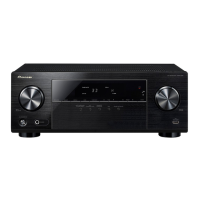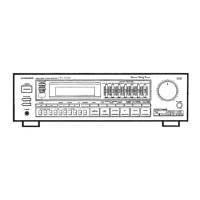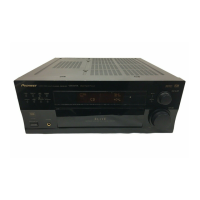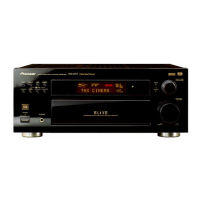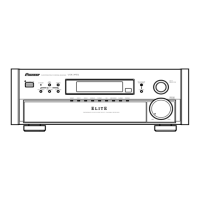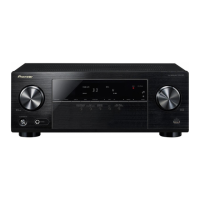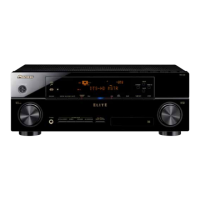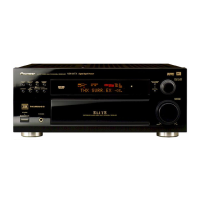Do you have a question about the Pioneer Elite VSX-31 and is the answer not in the manual?
Crucial safety warnings regarding electrical hazards, liquid exposure, and proper usage.
Statement of compliance with FCC rules for digital devices and interference limits.
Comprehensive safety guidelines covering electrical shock, fire hazards, and ventilation.
Recommended temperature, humidity, and installation conditions for the unit.
Initial steps including checking box contents and loading batteries.
A step-by-step guide to connecting components and configuring the receiver.
List of accessories included with the receiver.
Guidelines for proper placement and installation of the receiver unit.
Instructions for inserting batteries into the remote control.
Identification and description of controls and indicators on the receiver's front panel.
Controls and indicators for operating the AM/FM tuner functions.
Buttons to select different audio playback and surround sound modes.
Terminals on the front panel for iPod, USB, HDMI, and MCACC microphone.
Lights indicating input signals, program formats, and digital audio formats.
Indicators for MULTI-ZONE, SOUND features, and listening modes.
Indicators for tuner status such as TUNED, STEREO, MONO.
Indicators for selected input functions.
Indicators for selected speaker terminals (A or B).
Indicator for the remote control mode setting.
Buttons for accessing and adjusting receiver settings like menus and parameters.
Feature for programming and executing command sequences.
Buttons for controlling connected components like TVs and other devices.
Buttons for menu navigation, volume adjustment, and basic playback.
Guidelines and limitations for effective remote control operation.
Diagram and identification of all rear panel input and output terminals.
Default assignments of input functions to receiver terminals.
Guidance on selecting speaker system setups like 7.1, front height, front wide, and Speaker B.
Setup for a 7.1 system using front wide speakers.
Setup for 7.1 system with additional Speaker B connection.
Setups for 5.1 systems including Bi-Amping and ZONE 2 connections.
Options for connecting fewer than 5.1 speakers or without a subwoofer.
Recommended speaker placement for optimal surround sound effects.
Guidelines to maximize sound quality through speaker placement.
Detailed instructions for connecting speaker wires to receiver terminals.
Method for connecting speaker cables using banana plugs.
Visual guide for connecting speakers to the receiver's terminals.
Connecting speakers to separate amplifiers for improved sound quality.
Connecting speakers with two sets of wires for enhanced audio performance.
Configuring speaker system settings like Front Height, Front Wide, Speaker B, Bi-Amp, ZONE 2.
Explanation of different audio input and output terminal types and signal priority.
How the video converter ensures all video sources output through MONITOR OUT.
Steps for establishing HDMI connections for synchronized operations.
Explanation of HDMI connection capabilities, digital audio formats, and technology.
Connecting DVD players without HDMI using analog or digital audio/video.
Connecting TVs without HDMI input using composite/component video and HDMI for audio.
Connecting satellite/cable receivers and digital TV tuners to the receiver.
Connecting HDD/DVD recorders and BD recorders for audio/video playback.
Connecting various audio components for playback, including analog recorders.
Information on the built-in WMA9 Pro decoder for encoded audio playback.
Instructions for connecting AM loop and FM wire antennas.
Guidance on connecting external antennas for improved reception.
Setting up independent audio systems in multiple rooms.
Steps for establishing connections for multi-room audio playback.
Configuring MULTI-ZONE using surround back speaker terminals.
Connecting a Bluetooth adapter for wireless music enjoyment.
Connecting and activating a SiriusConnect tuner for satellite radio broadcasts.
Connecting the receiver to a network for Internet radio access.
Connecting HDMI devices to the front panel input for high-quality video.
Connecting video devices to the front panel video terminal.
Connecting an iPod for audio playback and control via the receiver.
Connecting USB devices for audio/photo playback and text input.
Using USB devices to transfer MCACC data to a computer for analysis.
Connecting an IR receiver for remote control of components in cabinets.
Linking Pioneer components to use a single remote sensor chain.
Automating component power control using 12V trigger signals.
Final step of connecting the receiver's power cord to an outlet.
How to change the on-screen display language.
Guided setup for automatic speaker calibration and room acoustics optimization.
Information about THX technology and its integration.
Connecting the calibration microphone for MCACC measurements.
Choosing settings like THX Speaker and STAND.WAVE Multi-P for calibration.
Waiting for calibration tones and verifying speaker configuration.
Completing the automatic speaker calibration process and confirming settings.
Troubleshooting common issues encountered during Auto MCACC setup.
Configuring input assignments for connected components.
Default assignments and options for receiver input functions.
Basic steps to play audio and video sources through the home theater system.
Playing sources connected via HDMI, including audio output options.
Connecting and controlling an iPod for audio playback.
Browsing and selecting songs from a connected iPod.
Switching control between iPod and receiver for iPod operations.
Playing audio and photo files from USB storage devices.
Navigating and playing audio files from USB memory.
Viewing photo files from USB memory as a slideshow.
Customizing slideshow settings like theme, interval, and background music.
Lists supported music and photo file formats for USB playback.
Tuning into FM and AM radio stations using automatic and manual methods.
Memorizing radio station frequencies for quick recall.
Assigning custom names to saved radio station presets for easier identification.
Recalling saved radio station presets for playback.
Using the Bluetooth adapter for wireless music playback from enabled devices.
Steps to establish a Bluetooth connection between the adapter and device.
Playing music from a Bluetooth device after pairing and connection.
Accessing and playing Internet radio stations.
Storing desired Internet radio stations for easy selection.
Method for programming Internet radio stations using the receiver's GUI.
Alternative method for programming Internet radio stations via a computer.
Connecting and listening to SIRIUS Satellite Radio broadcasts.
Memorizing SIRIUS radio channels for quick recall.
Recalling saved SIRIUS radio channels.
Accessing additional SIRIUS radio features like channel skip and parental lock.
Automatic selection of surround or stereo playback based on source.
Experiencing surround sound from various sources and speaker setups.
Using basic surround sound modes for stereo and multichannel sources.
Detailed explanation of standard surround modes like Dolby Pro Logic IIx and Neo:6.
Applying various advanced surround sound effects for film and music.
Listening to sources in stereo, including Front Stage Surround Advance modes.
Creating surround sound effects using only front speakers and subwoofer.
Experiencing pure analog or digital sound by bypassing signal processing.
Switching between calibrated MCACC sound settings for different listening positions.
Selecting the appropriate input signal type (AUTO, DIGITAL, HDMI, PCM) for a source.
Using Phase Control to improve sound reproduction by preventing distortion.
Connecting components for synchronized operations using HDMI.
Configuring receiver settings for Control with HDMI functions.
Prerequisites and steps before enabling synchronized operations.
How components operate in sync using the Control with HDMI function.
Using Control with HDMI with non-Pioneer brand components.
Configuring the Precision Quartz Lock System for improved audio playback.
Important considerations and potential issues when using Control with HDMI.
Adjusting various audio settings like MCACC, EQ, Delay, and Tone Controls.
Explanation of TREBLE, S.RTRV, DNR, DIALOG E, DUAL, DRC, LFE, SACD GAIN, HDMI, A.DELAY.
More audio settings including C. WIDTH, DIMENSION, PANORAMA, C. IMAGE, EFFECT, H.GAIN, V.SB, V.HEIGHT.
Adjusting picture settings like Digital Video Conversion and Resolution.
More video settings including ASP, PCINEMA, P.MOTION, YNR, DETAIL, SHARP, BRIGHT, CONTRAST, HUE, CHROMA.
Selecting speaker terminals (A, B, or off) for audio output.
Controlling the sub zone volume and source selection.
Recording audio or video from sources connected to the receiver.
Operating the MULTI-ZONE sub zone using remote controls.
Adjusting input level for strong analog signals to prevent distortion.
Setting a timer to automatically switch the receiver to standby.
Viewing current receiver settings, including MCACC presets and ZONE 2 input.
Restoring all receiver settings to factory defaults.
List of default settings for various receiver functions.
Operating multiple receivers using the remote control.
Programming the remote to control other audio/video components.
Directly selecting preset codes for controlling components.
Learning remote control signals from other devices.
Resetting individual remote control button settings to default.
Resetting specific input function button assignments to their defaults.
Enabling direct control of one component while using receiver for another.
Programming sequences for multi-component power on/off operations.
Steps to create command sequences for Multi operation or System off.
Executing programmed multi-operation sequences.
Executing programmed system-wide power-off sequences.
Deletin g programmed multi-operation settings.
Erasing all remote control preset codes and programmed buttons.
Using the remote to control connected components via input function buttons.
Detailed mapping of remote control buttons to functions for TV, BD/DVD, HDD/DVR, VCR, SAT/CATV.
Mapping of remote control buttons for LD, CD/CD-R/SACD, MD/DAT, TAPE, TV, Projector.
Introduction to the Advanced MCACC system for detailed sound field calibration.
Detailed customization of MCACC setup for specific listening positions.
Connecting the calibration microphone for MCACC measurements.
Choosing settings like THX Speaker and STAND.WAVE Multi-P for calibration.
Finalizing the automatic speaker calibration process and confirming settings.
Reviewing calibrated settings for speaker system, channel level, and distance.
Making detailed, manual adjustments to the sound field calibration.
Adjusting the overall balance of speaker system channel levels.
Setting precise delay and distance for each speaker for sound depth.
Controlling resonant low frequencies in the listening area using filters.
Manually adjusting speaker system frequency balance based on room acoustics.
Calibrating system based on direct sound, minimizing room reverberation.
Viewing EQ ON/OFF status and checking reverb characteristics.
Reviewing calibrated settings for speaker system, channel level, and distance.
Displaying speaker size, number, and distance configurations.
Displaying standing wave values and EQ calibration for MCACC presets.
Transferring MCACC data to USB for computer analysis.
Storing, renaming, copying, and clearing MCACC presets.
Assigning names and copying settings between MCACC presets.
Removing unused MCACC presets from memory.
Changing speaker, input, OSD language, and network settings.
Making detailed settings to optimize surround sound performance.
Selecting speaker system types and surround speaker placement.
Configuring speaker system type (Normal, Speaker B, Bi-Amp, ZONE 2).
Specifying speaker size, number, crossover frequency, and bass redirection.
Adjusting the overall balance of speaker system channel levels.
Specifying speaker distances for proper sound depth and delay.
Adjusting tonal balance for cinema sound, re-equalizing for home theater.
Configuring network settings for Internet radio access.
Setting IP address, subnet mask, and proxy server details.
Defining the IP address ranges required for Internet radio.
Accessing the receiver's MAC address via the network setup menu.
Accessing customized settings for receiver usage.
Configuring power-on volume level, volume limit, and mute level.
Setting receiver's remote control mode to prevent erroneous operation.
Adjusting GUI screen resolution to improve visibility.
Troubleshooting issues related to the receiver's power supply and operation.
Steps to diagnose and resolve issues related to lack of audio output.
Diagnosing no sound from specific speaker types, subwoofer, or single speakers.
Resolving issues with analog vs. digital audio and Dolby/DTS formats.
Addressing various audio-related issues like broadcast reception and noise.
Troubleshooting video output issues, including no image and distorted picture.
Troubleshooting issues with MCACC setup, speaker settings, and remote control.
Understanding graphical EQ output and troubleshooting display issues.
Troubleshooting display issues like darkness, going off, or not showing DIGITAL.
Troubleshooting remote control operation and component control issues.
Troubleshooting HDMI connection issues like blinking indicators, no picture, no sound, and HDCP errors.
Configurations and tips for routing HDMI signals through the receiver.
Troubleshooting issues with USB devices, folders, files, keyboards, and formats.
Troubleshooting Bluetooth device connection and sound issues.
Troubleshooting network access and station playback for Internet radio.
Explaining SIRIUS radio messages and troubleshooting steps.
Information about "Made for iPod" and "Works with iPhone" certifications.
Brief descriptions of Dolby, DTS, and WMA9 Pro surround sound formats.
Charts showing listening modes based on input signal formats and speaker configurations.
List of preset codes for controlling various TV manufacturers and components.
Continuation of preset codes for TV, DVD, DVR, BD, VCR, SAT/CATV.
Continuation of preset codes for Cable Set Top Box, CD, Laser Disc Player, Cassette Deck, Digital Tape, MD.
Continuation of preset codes for Cable Set Top Box (Combination) and CD-R.
Final part of preset codes for Laser Disc Player, Cassette Deck, Digital Tape, MD.
Technical specifications for amplifier, audio, video, tuner, and digital sections.
Instructions for cleaning the receiver unit to maintain its appearance.
Information on safe listening levels to protect hearing.
Websites for product registration, service, and accessory purchases.
| carton length | 20.20 inches |
|---|---|
| carton width | 9.69 inches |
| carton height | 19.09 inches |
| carton weight | 27 lbs 5 oz |
| width | 16.54 inches |
|---|---|
| height | 6.22 inches |
| depth | 14.92 inches |
| weight | 22 lbs 8 oz |
